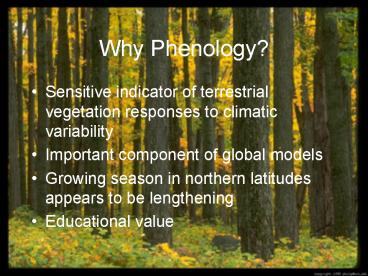Why Phenology PowerPoint PPT Presentation
1 / 42
Title: Why Phenology
1
Why Phenology?
- Sensitive indicator of terrestrial vegetation
responses to climatic variability - Important component of global models
- Growing season in northern latitudes appears to
be lengthening - Educational value
2
(No Transcript)
3
1. Developing a Phenological Model
4
Growing Season Variability in Global Carbon
Models
- Simulated growing season length varies from five
to ten months - Need to establish realistic and consistent
methods of regulating the timing and length of
the growing season
5
Step One
- Satellite Observations
6
(No Transcript)
7
Data Set
- U.S. Advanced Very High Resolution Radiometer
- 1990-1992 daily observations
- 20 km x 20 km contiguous land cover sites
- Extracted deciduous broadleaf forest and
grassland sites
8
(No Transcript)
9
(No Transcript)
10
Step Two
- Meteorological Interpolation
11
Weather Station Distribution
12
(No Transcript)
13
1990
1990 1991 1992
deg C
deg C
gt32
lt-2
gt2
lt5
11
1990 1991 1992
cm
cm
gt300
lt5
lt-30
gt30
14
Step Three
- Model Development and Results
15
Development Method
- Select a meteorological model that best predicts
the satellite observations - Traditional phenological models thermal
summations, daylength, and drought stress - Parameter selection based on iterative
cross-validation procedure
16
(No Transcript)
17
Phenology Model Summary
18
DBF Onset
DBF Offset
Grassland Onset
Grassland Offset
19
(No Transcript)
20
2. Growing Season Influences on Ecosystem
models
21
SITE DISTRIBUTION
Mean Ann Temp
7.8
C
9.4C
11.8C
16.3C
22
Growing Season Length vs. Mean Annual Temperature
23
(No Transcript)
24
(No Transcript)
25
Charleston, SC
Burlington, VT
26
3. The Need for Field Data
27
Ground Measurements
- Hubbard Brook and Harvard Forest LTER phenology
- Onset 30 leaf expansion
- Offset initial canopy senescence
- Inconsistent methodologies
28
Comparison of Observed and Modeled Phenology
29
Ground monitoringmethods at the Jornada LTER
30
Jornada Transitional Site
31
(No Transcript)
32
Site of Near-death Experience
33
(No Transcript)
34
Effects of Increased Sample Size on sample
standard deviation
35
Instrument Intercomparison
FT FG PAI LAI
36
Science Education (creative data-gathering)
- Global Learning and Observations to Benefit the
Environment (GLOBE) - Students measure budburst of local dominant
species - Useful for interpretation of satellite data
- Easily observable demonstration of
climate-vegetation connection
37
(No Transcript)
38
(No Transcript)
39
(No Transcript)
40
(No Transcript)
41
Conclusions
- Phenology is one of the most important topics in
climate change research - Next generation of satellites - MODIS - will
bring unprecedented ability to monitor growing
season dynamics - Future topics include health and economic
implications - Excellent field for internet-based student
involvement
42
(No Transcript)

